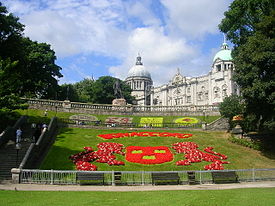Union Terrace Gardens
| Union Terrace Gardens | |
|---|---|

Aberdeen's Floral Crest with His Majesty's Theatre in background.
|
|
| Type | Public Garden |
| Location | Aberdeen, Scotland |
| Coordinates | 57°8′49″N 2°6′12″W / 57.14694°N 2.10333°W |
| Area | 1 hectare (10,000 m²) |
| Created | 1879 |
| Operated by | Aberdeen City Council |
| Status | Open all year |
Union Terrace Gardens is a public park and gardens situated on Union Terrace in Aberdeen, Scotland.
The sunken gardens opened to the public in 1879, and cover approximately two and a half acres . The space is bounded to the north by Rosemount Viaduct, to the south by Union Street, Aberdeen's main thoroughfare, to the east by the railway and the Den Burn, now flowing underground, and to the west by Union Terrace
Contrary to popular belief the area is not a natural amphitheatre but a small river valley with a late-Victorian viaduct constructed at the North end in 1889. The amphitheatre was formed from the covered remains of Denburn Terrace after demolition.
The park is surrounded by of some of the best architecture of Aberdeen, prominent among which are His Majesty's Theatre, St Mark's Church and the Library on Rosemount Viaduct to the north, and the Triple Kirks to the east.
On the park's north side is a formally planted and maintained floral crest of the city's coat of arms.
At the Union Street end of the gardens stands a group of mature elm trees, nearly 200 years old. The trees stand on the remnants of the site once known as Corbie Haugh: Corbie in Scots meaning crow, and Haugh meaning a low-lying meadow in a river valley. Corbie Haugh is still an apposite epithet for this area as crows still nest in the elms. The trees were originally planted to stabilise the embankment to prevent the newly widened Union Terrace from slipping into the gardens.
The arches which run along the length of Union Terrace were designed by architect James Matthews, who was instrumental in turning the area into a pleasure park.
In 2010 controversial plans were unveiled to transform the gardens.
On 19 May, Aberdeen City Council voted in favour of the City Square project to transform the heart of the city into a vibrant, cultural civic space and gardens. At the same time an alternative plan for a contemporary art centre in the gardens, the Peacock proposal, was rejected.
Local oil tycoon Sir Ian Wood pledged up to £85 million of his own money to back the City Square project to "ensure the economic survival of the city centre". The current version of the plan involves raising the level of the Gardens, creating a square which is to be a "cross between a grand Italian piazza and a mini Central Park." A technical appraisal carried out by the architectural firm Halliday Fraser Munro estimated the project would cost around £140 million to build. Andrew Dixon, incoming boss of Scotland's new arts and culture body, Creative Scotland, recently praised the project as a "real opportunity for the city". As part of the project councillors stipulated that at least £15 million be provided for a new cultural centre run by Peacock.
...
Wikipedia
